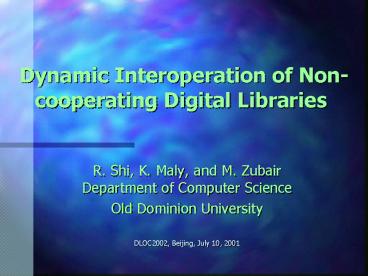Dynamic Interoperation of Noncooperating Digital Libraries PowerPoint PPT Presentation
1 / 20
Title: Dynamic Interoperation of Noncooperating Digital Libraries
1
Dynamic Interoperation of Non-cooperating
Digital Libraries
- R. Shi, K. Maly, and M. Zubair Department of
Computer Science - Old Dominion University
- DLOC2002, Beijing, July 10, 2001
2
Overview
- Introduction
- Background
- Architecture Design Enhanced LFDL
- Experimentation Implementation
- Conclusion Future Works
3
Introduction
- Many approaches for DL Interoperation
- Harvesting and distributed search
- Earlier work on LFDL Lightweight Federated
Digital Library - Universal search interface
- DL specification in DLDL
- DL registration
- Query mapping
- Limitations
- Search capabilities, QoS, performance
- Enhanced LFDL
- Interactive user-centered search
4
Background
- Levels of interoperability
- Technical protocol, format
- Contents data, metadata, messages
- Organizational rules for access, payment,
authentication, - General models
- Federation
- complete, but requires more from data providers
- Harvesting
- some efforts from both data and service providers
- Gathering
- Little from data providers
5
LFDL Introduction
- General principle
- Gathering and distributed search
- Lightweight both to data and service providers
- Basic solution
- Dynamic DL metadata registration
- Universal interface
- Dynamic Query mapping
- Efficient system management
- Local repository
6
LFDL Architecture
7
LFDL Services
- Registration service
- Metadata server
- Registration server
- Dynamic library proxy
- Rules engine
- Search service
- Search engine
- Result processing engine
- Management service
- DL removal, verification,
- Runtime info
- DL availability
- DL average response time
- Most often used queries
- System total hits
8
LFDL Design metadata specification
- DLDL in XML
- Structure
- General info on a digital library
- Mapping rules
- Access methods of the digital library
- Information to be retrieved from the digital
library - DTD
- All XML Specifications have a common Data Type
Definition (DTD) - Allows XML parser to check the validity of the
XML specification and whether it is well formed - Sample Specification for NEEDS (National
Engineering Education Delivery System)
9
Limitations and Issues
- Limited search capabilities
- Static, simple interface
- Quality of service
- Precision/recall need to be improved
- Obstacles
- DLs have different interfaces and unique features
- Unique features were lost when using simple
interface
10
Enhanced LFDL - Approach
- Simple vs. advanced search
- User friendly advanced search
- Approach
- User-centered interactive search
- Start from simple keyword
- Dynamic interface based on the keyword
- Dynamic query mapping based on interface
11
Enhanced LFDL - Design
- Keyword-driven dynamic interface
- Pre-defined keyword-hit set
- Base keyword set from OAI test-bed
- Generate keyword-hit set
- Interface generation
- Generic universal interface
- Based on Dublin Core
- Complete DL specification in DLDL
- Filter field type, name, values
- Mapping with UI field
- Allow DL unique features (no mapping)
12
Interface Generation Algorithm
- Factors
- Input keyword
- Generic base UI
- DL keyword-hit
- DL specification
- Algorithm
- Weight based DL features selection
- DL weight determined by keyword-hit
- Absolute feature weight within UI
- Relative feature weight within a DL
- User behavior from user features selection log
- Algorithm
- balance all weights
- select features with highest weight
13
Experimentation and Implementation - UI
14
Experimentation and Implementation keywords-hits
- ltFORMFIELDgt
- ltREQUIRED Title"Required Field or
not"gtYlt/REQUIREDgt - ltWEIGHT Title"Weight of Field"gt1lt/WEIGHTgt
- ltTYPE Title"Search Criteria or Display
Option"gtSearch Criterialt/TYPEgt - ltLABEL Title"Displayed Field
Name"gtKeywordslt/LABELgt - ltLENGTH Title"Field Length"gt35lt/LENGTHgt
- - ltINPUTNAMEgt
- ltINPUTNAME_VALUE Title"Internal Form
Name"gtkeywordslt/INPUTNAME_VALUEgt - ltINPUTNAME_MAPPING Title"Mapped UI Field
Name"gtUI_keywordlt/INPUTNAME_MAPPINGgt - lt/INPUTNAMEgt
- ltINPUTTYPE Title"Form Type"gttext
inputlt/INPUTTYPEgt - ltINPUTVALUE /gt
- lt/FORMFIELDgt
15
Experimentation and Implementation Interface
for keyword html
16
Experimentation and Implementation Interface
for keyword university
17
Evaluation
- Test-bed
- Approach comparison
- System measurements
- Tools and reports
- Reference data for participants
18
Evaluation - Performance
- Hypothesis
- LFDL will perform better or at least equal to the
sum of individual DLs - Metrics
- User response time
- Cache hit rate
- Control variables
- Baseline Data
- Log files of existing DLs
- Experimental Design
- From baseline data calculate query locality,
average response time - Simulation and get LFDL average response time
19
Evaluation Quality of Service
- Hypothesis
- LFDL will produce better or at least equal
quality of result set than the sum of the results
from individual DLs - Metrics
- Precision/Recall
- Control variables
- Baseline Data
- Log files of existing DLs
- Experimental Design
- From baseline data get result set of each DL
- Simulation and get precision/recall for LFDL
20
Conclusion and Future Works
- Federation service for non-cooperating DLs is
possible - Dynamic user-centered interface is practical to
improve quality of service - Future works
- Usability domain oriented, post-processing
- Complex interface mapping, access control
- Scalability, and performance
- Automatic specification generation

